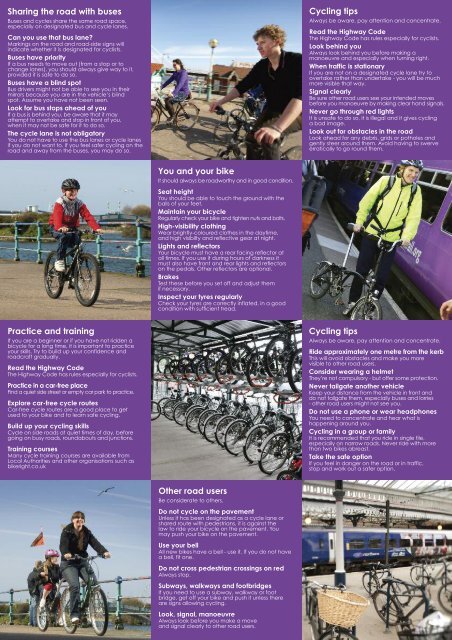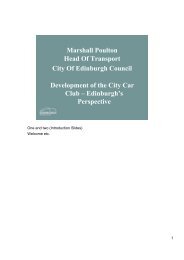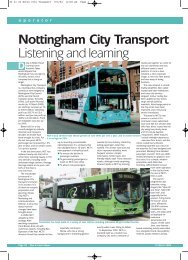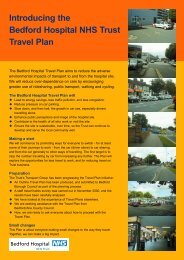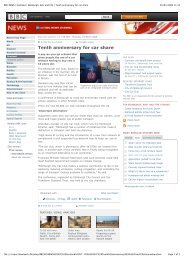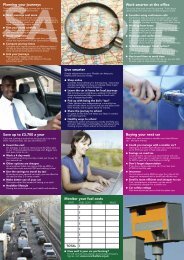Northern Rail Cycle 140312.pdf - Richard Armitage Transport ...
Northern Rail Cycle 140312.pdf - Richard Armitage Transport ...
Northern Rail Cycle 140312.pdf - Richard Armitage Transport ...
Create successful ePaper yourself
Turn your PDF publications into a flip-book with our unique Google optimized e-Paper software.
Sharing the road with buses<br />
Buses and cycles share the same road space,<br />
especially on designated bus and cycle lanes.<br />
Can you use that bus lane?<br />
Markings on the road and road-side signs will<br />
indicate whether it is designated for cyclists.<br />
Buses have priority<br />
If a bus needs to move out (from a stop or to<br />
change lanes), you should always give way to it,<br />
provided it is safe to do so.<br />
Buses have a blind spot<br />
Bus drivers might not be able to see you in their<br />
mirrors because you are in the vehicle’s blind<br />
spot. Assume you have not been seen.<br />
Look for bus stops ahead of you<br />
If a bus is behind you, be aware that it may<br />
attempt to overtake and stop in front of you,<br />
when it may not be safe for it to do so.<br />
The cycle lane is not obligatory<br />
You do not have to use the bus lanes or cycle lanes<br />
if you do not want to. If you feel safer cycling on the<br />
road and away from the buses, you may do so.<br />
Cycling tips<br />
Always be aware, pay attention and concentrate.<br />
Read the Highway Code<br />
The Highway Code has rules especially for cyclists.<br />
Look behind you<br />
Always look behind you before making a<br />
manoeuvre and especially when turning right.<br />
When traffic is stationary<br />
If you are not on a designated cycle lane try to<br />
overtake rather than undertake - you will be much<br />
more visible that way.<br />
Signal clearly<br />
Be sure other road users see your intended moves<br />
before you manoeuvre by making clear hand signals.<br />
Never go through red lights<br />
It is unsafe to do so, it is illegal and it gives cycling<br />
a bad image.<br />
Look out for obstacles in the road<br />
Look ahead for any debris, grids or potholes and<br />
gently steer around them. Avoid having to swerve<br />
erratically to go round them.<br />
You and your bike<br />
It should always be roadworthy and in good condition.<br />
Seat height<br />
You should be able to touch the ground with the<br />
balls of your feet.<br />
Maintain your bicycle<br />
Regularly check your bike and tighten nuts and bolts.<br />
High-visibility clothing<br />
Wear brightly-coloured clothes in the daytime,<br />
and high visibilty and reflective gear at night.<br />
Lights and reflectors<br />
Your bicycle must have a rear facing reflector at<br />
all times. If you use it during hours of darkness it<br />
must also have front and rear lights and reflectors<br />
on the pedals. Other reflectors are optional.<br />
Brakes<br />
Test these before you set off and adjust them<br />
if necessary.<br />
Inspect your tyres regularly<br />
Check your tyres are correctly inflated, in a good<br />
condition with sufficient tread.<br />
Practice and training<br />
If you are a beginner or if you have not ridden a<br />
bicycle for a long time, it is important to practice<br />
your skills. Try to build up your confidence and<br />
roadcraft gradually.<br />
Read the Highway Code<br />
The Highway Code has rules especially for cyclists.<br />
Practice in a car-free place<br />
Find a quiet side street or empty car park to practice.<br />
Explore car-free cycle routes<br />
Car-free cycle routes are a good place to get<br />
used to your bike and to learn safe cycling.<br />
Build up your cycling skills<br />
<strong>Cycle</strong> on side roads at quiet times of day, before<br />
going on busy roads, roundabouts and junctions.<br />
Training courses<br />
Many cycle training courses are available from<br />
Local Authorities and other organisations such as<br />
bikeright.co.uk<br />
Cycling tips<br />
Always be aware, pay attention and concentrate.<br />
Ride approximately one metre from the kerb<br />
This will avoid obstacles and make you more<br />
visible to other road users.<br />
Consider wearing a helmet<br />
They’re not compulsory - but offer some protection.<br />
Never tailgate another vehicle<br />
Keep your distance from the vehicle in front and<br />
do not tailgate them, especially buses and lorries<br />
- other road users might not see you.<br />
Do not use a phone or wear headphones<br />
You need to concentrate and hear what is<br />
happening around you.<br />
Cycling in a group or family<br />
It is recommended that you ride in single file,<br />
especially on narrow roads. Never ride with more<br />
than two bikes abreast.<br />
Take the safe option<br />
If you feel in danger on the road or in traffic,<br />
stop and work out a safer option.<br />
Other road users<br />
Be considerate to others.<br />
Do not cycle on the pavement<br />
Unless it has been designated as a cycle lane or<br />
shared route with pedestrians, it is against the<br />
law to ride your bicycle on the pavement. You<br />
may push your bike on the pavement.<br />
Use your bell<br />
All new bikes have a bell - use it. If you do not have<br />
a bell, fit one.<br />
Do not cross pedestrian crossings on red<br />
Always stop.<br />
Subways, walkways and footbridges<br />
If you need to use a subway, walkway or foot<br />
bridge, get off your bike and push it unless there<br />
are signs allowing cycling.<br />
Look, signal, manoeuvre<br />
Always look before you make a move<br />
and signal clearly to other road users.
Road signs for cyclists<br />
The Highway Code has a range of signs relating to<br />
cycling. You should learn their meanings and obey them.<br />
More road signs for cyclists<br />
Routefor topedal<br />
be<br />
used cycles by only pedal<br />
cycles only<br />
<strong>Cycle</strong> route<br />
Pedal cycle route<br />
ahead<br />
No cycling<br />
Riding of pedal<br />
cycles prohibited<br />
Recommended<br />
Route<br />
recommended route for for<br />
pedal cycles<br />
pedal cycles<br />
With-flow cycle pedal lane<br />
ahead cycle(may lane ahead also be<br />
designated for bus<br />
and taxi use)<br />
With-flow<br />
pedal cycle<br />
lane<br />
With-flow pedal<br />
cycle lane<br />
Shared route for<br />
pedal cycles and<br />
pedestrians only<br />
Shared route for<br />
pedal cycles and<br />
pedestrians only<br />
Contra-flow<br />
Contra-flow pedal<br />
pedal<br />
cycle lane<br />
cycle<br />
lane<br />
With-flow<br />
bus and pedal<br />
cycle lane<br />
Segregated<br />
Separated track<br />
pedal cycle<br />
path for pedal<br />
and pedestrian<br />
cycles and<br />
route<br />
pedestrians<br />
Parking place<br />
for pedal cycles<br />
Parking place for<br />
pedal cycles<br />
Get off your<br />
bicycle and<br />
push it<br />
Things to look out for<br />
Spot the potential dangers.<br />
Drivers misjudging your speed<br />
Drivers often underestimate a bicycle’s speed<br />
and pull out in front of you.<br />
Left hand side streets<br />
Be aware of traffic pulling out from left hand side<br />
streets and into your path. The driver may not see<br />
you, so be prepared to brake.<br />
Parked car door opening<br />
When you pass a parked car, leave space of more<br />
than a door’s width between you and the car.<br />
The blind spot<br />
Vehicles, especially buses and lorries, may not be<br />
able to see you. Assume they cannot.<br />
Vehicle overtakes you approaching junction<br />
Be aware that the vehicle might try to turn left in<br />
front of you.<br />
Narrowing of the road ahead of you<br />
If the road narrows, try to move to the middle of the<br />
lane. Do not squeeze to the kerb as you will be<br />
inviting vehicles to pass when there isn’t enough room.<br />
Cycling is fun, healthy,<br />
cheap and often the<br />
quickest option.<br />
If you follow a few basic<br />
rules, it is also safe.<br />
Please take a few minutes to<br />
read this leaflet and follow<br />
the advice.<br />
A pocket<br />
guide to<br />
cycling<br />
You can find more at<br />
loveyourbike.org<br />
Bikes on trains<br />
<strong>Northern</strong> <strong>Rail</strong> is strongly committed to promoting cycling<br />
as a sustainable and healthy means of transport that<br />
complements our train service. Our vision is to ‘connect<br />
people to opportunities by the most sustainable means’<br />
and cycling has an important role to play.<br />
Bikes are carried free of charge at any time<br />
and you don’t need to make reservations.<br />
The cycle space on trains is clearly marked, both<br />
internally and externally. Space is allocated on<br />
We can only carry a maximum of two bikes per train<br />
but conductors have responsibility for the safety of<br />
their train and have the right to refuse entry if the<br />
train is busy.<br />
Visit our website, northernrail.org for more information.<br />
© Manchester Friends of the Earth Ltd.<br />
Produced by <strong>Richard</strong> <strong>Armitage</strong> <strong>Transport</strong> Consultancy Ltd.<br />
ratransport.co.uk


